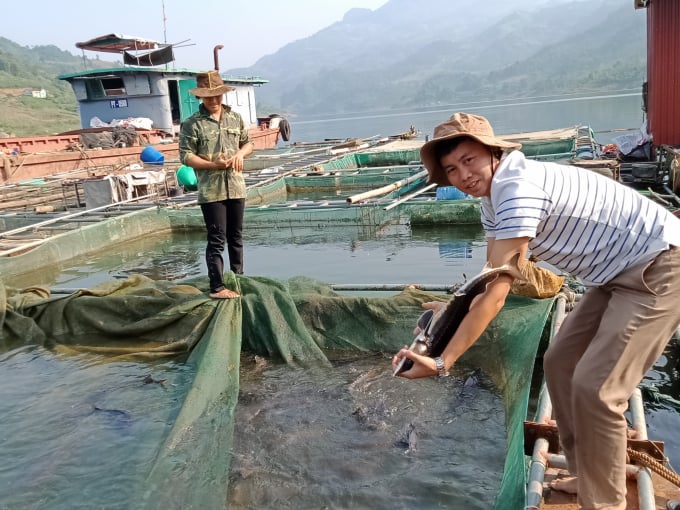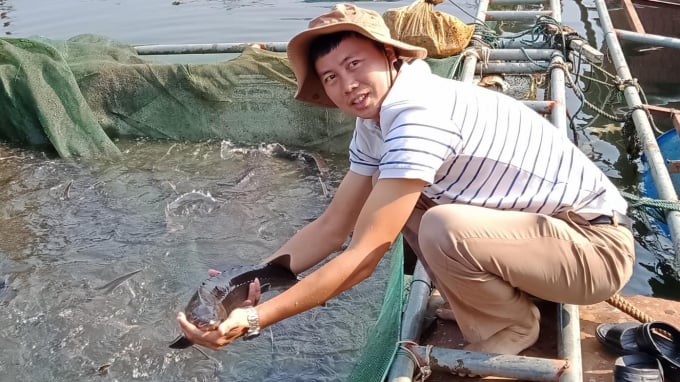November 27, 2025 | 13:22 GMT +7
November 27, 2025 | 13:22 GMT +7
Hotline: 0913.378.918
November 27, 2025 | 13:22 GMT +7
Hotline: 0913.378.918
Lao Cai province currently has over 14,000 hectares of water surface (including 3,000 hectares of small ponds and lakes, 1,100 hectares of reservoirs) and many low-productivity farming fields that can be converted to aquaculture. The small ponds and reservoirs mainly raise traditional fish species as well as fish with average economic value such as grass carp, hybrid carp, tilapia, drifting fish, catfish, etc. The province currently has over 50,000m3 of cold water fish tanks including rainbow trout and sturgeon. The province's annual fish production reaches over 5,300 tons.
Aquaculture in Lao Cai generally faces many challenges and limitations such as small, scattered ponds and lakes; the province mainly raises traditional fish following extensive or semi-intensive farming methods using local agricultural by-products; the utilization of water sources from river and reservoir for cage fish farming is low, efficiency is not high.

The model demonstrated that sturgeon raised in cages in the hydroelectric reservoir bed grows exceptionally with high quality. Photo: Luu Hoa.
Lao Cai Agricultural Extension and Agricultural Service Center deployed a model of raising sturgeon in cages in 2021 to ensure food safety in Ta Thang commune (Muong Khuong district) and Coc Ly commune (Bac Ha district). Both of the communes are in impoverished areas, under new rural areas construction; the communes are in the provincial planning area for cage fish farming, with a need to develop commodity-oriented fisheries. Furthermore, Coc Ly hydroelectric reservoir has deep and clean water source.
However, the implementation of the model has encountered some difficulties including: The level of awareness of households raising fish in cages is low and inconsistent; The capacity to apply techniques in nurturing, rearing and disease prevention for caged fish, especially sturgeon, is limited.
To overcome difficulties and existing problems and to capitalize the potential of aquaculture development, Lao Cai Center for Agricultural Extension and Agricultural Services has deployed a model with the goal of demonstrating and transferring the technological advancement of sturgeon farming in cages on rivers and reservoirs following VietGAP standards to ensure food safety as well as increase income for local farmers. Additionally, the model serves as a basis to develop aquaculture and support sustainable new rural construction in the area.
The Center starts implementation from the stages of selecting sites, selecting households to guiding fish farmers towards VietGAP evaluation standards in aquaculture. The center also assigns qualified, responsible and experienced staff to directly guide farmers; they will also instruct farmers on techniques to make cages, stock fish and measures to nurture, manage and prevent fish diseases.

The model's success will bring many opportunities for the development of fish cage farming on the hydroelectric reservoir bed in Lao Cai. Photo: Luu Hoa.
In addition, to ensure the progress and desired results of the model, the Center cooperates with the People's Committees of Muong Khuong and Bac Ha districts and other specialized departments to directly inspect, monitor and evaluate the project progress at base. As a result, all of the households will have the appropriate fish to raise. The nurturing of fish also complies with technical procedures. Farming cages are secure, yielding positive results after 12 months of raising.
Regarding fish raised in the model: Sturgeons raised in cages by 4 households has a survival rate of 75% by April 2022, the average weight reaches 2 kg/fish; total profit is 293.2 million VND; each household makes an average profit of 73.3 million VND per 50m3 of cages. Each worker can raise 4 times the volume in reality (ie 200m3).
For fish raised outside the model (Red flamingo fish): After 12 months of raising 2 litters of red snapper in cages by 4 households, the survival rate is 70%; the average weight reaches 0.55kg/fish, total profit is 145 million VND, each household makes an average profit of 36.25 million VND per 50m3. The model shows that each worker can raise 4 times the volume in reality (ie 200m3); and the income is on par with other traditional fish farming such as grass carp, carp, etc.
Contrasting fish raised in and outside the model: After 12 months, sturgeons in the model's cage have an average survival rate of 75%; average fish weight reaches 2 kg/fish, exceeding the survival rate in the plan by 5% and exceeding the weight by 0.2 kg/fish. By the same comparision, economic efficiency of fish raised in the model increased by 202%. Raising sturgeon in a large, clean, cool water source and supplemented with fresh small fish helped improve product quality, facilitate consumption and sustainable development.
The model has capitalized the strengths of the local Red River and Chay River systems, flowing through many districts and nearly 30 hydroelectric reservoirs in the highlands to develop cage fish farming and caged sturgeon farming. This has ensured food safety and increased income sustainably.
In addition to increasing income for participating households, the model has contributed to popularizing new techniques through field trips, seminars, training courses outside the model; so that farmers can raise awareness and change farming practices. The model has created caged sturgeon farming jobs to ensure food safety and restructure aquaculture. Farming households participating in the model are very pleased and wish the model to be further developed and replicated.
The successful model of caged sturgeon farming is a new direction to be replicated, as well as a driving force to support highland localities to capitalize the advantages of hydroelectric reservoirs in combination with ecological micro-climate to create a cool water source in the summer, serving the development of aquaculture in association with eco-tourism along the value chain to increase income sustainably.
Translated by Nguyen Hai Long

(VAN) Tay Ninh’s livestock sector is undergoing a major transformation, applying high-tech, closed-loop circular models to build sustainable value chains.
/2025/11/26/3627-4-082628_818.jpg)
(VAN) From a small café on the red basalt highlands, Le Van Hoang started a business with clean coffee, building Enjoi Coffee into a symbol of organic agriculture in the Lam Dong plateau.
/2025/11/25/0045-1-135246_13.jpg)
(VAN) Ca Mau is researching a model of sea-encroaching embankments combined with viaducts and logistics service zones, aiming both to prevent erosion and create land funds for marine economic development.

(VAN) The information was shared at the seminar 'Urban Agriculture - Solutions for Developing Green Spaces,' organized by the Kinh te & Do thi Newspaper and the Biotechnology Center of Ho Chi Minh City.
/2025/11/19/4141-2-132831_216.jpg)
(VAN) One of Japfa's outstanding solutions is implementing digital transformation and artificial intelligence (AI) to optimize operations, enhance productivity, and advance sustainable development.
/2025/11/19/4847-1-093540_448.jpg)
(VAN) The Gia Lai Provincial People’s Committee had a working session with the delegation of the U.S. Department of Agriculture, the State of Idaho, and representatives of the State's leading enterprises.

(VAN) Ca Mau has a sufficient foundation to become a strong regional aquaculture center, where production integrates the economy, the environment, and the lives of the people.